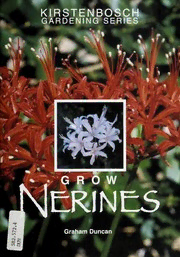
Grow Nerines PDF
Preview Grow Nerines
4 . 572 582. BotNAaT nI OiN AcLal INSTITUTE Acknowledgements I would liketothankCameron McMasterfor his assistance overmanyyearswiththe living collection ofnerines at Kirstenbosch, aswell as my mother, Judyvan Warmelo, atwhose suggestionthis guide waswritten. I alsothank allthosewho kindly contributed slidesfor publication and plantmaterial forstudy, and DennisTsang for helpful comments on the manuscript. MarietaVisagie provided thewatercolourof Nerinesarniensis, specially painted forthis publication. Technical editor: Deirdre Snijman General editor: CarolineVoget Design: David Davidson, Valerie Phipps-Smith Gardening Seriesco-ordinator: Neville Brown Published bythe National Botanical Institute, Kirstenbosch, Private Bag X7, Claremont, 7735, South Africa Website: http://www.nbi.ac.za Copyright(textand painting ofwhiteform ofNerinesarniensis) 2002 National Botanical Institute Copyright(photographs)the photographers Copyright(painting ofscarletform of Nerinesarniensis) MarietaVisagie ..a---.-- ISBN 1-919684-33-6 Reproduction by Castle Graphics Printed and bound byTrident Press © Kirstenbosch Gardening Series GROW Nerines A GUIDETOTHE SPECIES, CULTIVATION AND PROPAGATION OFTHE GENUS NERINE Text by Graham Duncan Photographs by Graham Duncan exceptwhere credited SS2.S12.I+ 33UN -Wts -7H20 2 , Right:Nerinemasoniorumfrom theEasternCapeiscritically endangeredinthewild Below:Nerinelaticomain habitat,NorthernProvince 2 CONTENTS A briefhistory5 General information 7 Taxonomy Growth cycle Flowersandfruits Foliage Distribution and habitat Conservation Winter-growingspecies J 1 Summer-growingspecies 25 Evergreen species 51 Nerine hybridsandcultivars 47 Cultivation 51 Aspectand climate Uses in the garden Containersubjects Growing medium Planting Watering Feeding Ftardiness Nerine hybridsfrom Exburtj Gardens 5b Propagation b5 Seed Offsets Twin-scaling Micropropagation Pestsanddiseases b5 Purtherreading 68 Useful addresses /I Sourcesofsupply 75 Glossary 74 Index 77 3 4 A 5RIER HISTORY Theglittering autumn bloomsof Nerine sarniensis widelyconsideredthemost , beautiful ofallthe nerines, hasan equally colourful history. Theoften-told, butunlikely taleofhow boxesof bulbsofourmost famous Nerine consignedfor Holland, , washed upontheshoresofGuernseyin theChannel Islands in 1659asaresultofa Dutch orEnglish shipwreck, andflourished there, has becomesomething ofa botanical legend. Actually, the plantwas originallythoughttohave been anativeof Japan! The phrase name Narcissus JaponicusRutiloFlore which , accompanied thefirstdescription and illustration ofthis species, published in 1635 bythe Parisian physician, Jacob Sargeant Cornut, was based on a plantwhich flowered inthegardenofJean Morin in Percy Paris in October 1634, and clearlyattests Above:Nerinesarniensis, to its supposed Japaneseorigin. Itwas Wreedsdtiesrhn-oCraapngeeforminhabitat, Robert Morison, ProfessorofBotanyat Oxford, whocan be held responsiblefor Lseafrtn:iSecnasrilseftrfoomrmthoefWNeesrtienren the mistaken origin ofthisspeciesas itwas Cape.Reproducedfromthe hewhosuggested in 1680thatithad oVriisgaigniaelwatercolourbyMarieta established itselfonthe coastofGuernsey afterbeing castawayfrom asinking ship, AfobromveofriNgehrt:inDeeseaprnrioesnes-ipsinfkrom enroutefromJapan. The mistaken theWesternCape assumptionthatthis speciesoriginated in Japan almostcertainlystemsfrom confusionwiththesuperficial resemblance ofthe rose-red orscarletflowersand similarstrap-shapedfoliageofthe 5 Lett:Nerinesarniensis ‘KirstenboschWhite', reproducedfromtheoriginal watercolourbyEllaphieWard- Hilhorst Right:Nerinehumilis,large formfromthesouthernCape (=N.peersii) Morison, in an attempttoconceal anyassociationwith Lambert, may have purposelyfalsifiedtheorigin of the plant. In 1753, when Linnaeus published his SpeciesPlantarum, he included this plantunderthe name Amaryllissarniensis, naming itafterSarnia, the Roman namefor Guernsey. Such wastheconviction thatGuernseywasthis plant's natural home, itsoon became known locallyastheGuernseylily, a namewhich has been steadfastly maintained untiltoday; indeed in 1958, a3d. postagestamp issued byGuernseydepictsourwell- travelled Nerine! N. sarniensishas been cultivated on Guernseyfor morethanthreecenturies, and it 2.6QtBWryauLa&gTg^IVM/.TURS>-£AVES 3.FPti'.T -4.^-: continuesto be grownthereforits cutflowers. Similarly, ourequally amaryllid Lycorisradiata. This species is famous belladonnalily, Amaryllis endemic inJapan and is knownto have belladonna, which has become naturalised occurred on surrounding hillsabovethe on neighbouringJersey, istoday boldly portcityofNagasaki, overlooking its depicted on postcardsthere, and famous harbour. resolutely referredto astheJersey lily! Thereisan alternative, albeitfar-fetched However, itwas Francis Masson, who hypothesisastothe reasonsforMorison’s morethan acenturyafteritsoriginal suggestionthatthe bulbswereof publication, was creditedwiththe Japaneseorigin, aswell astohowthey discoveryofthe real native habitatof cameto be grownon Guernsey. Inthe N. sarniensisonTable Mountain and 1650s, N. sarniensisis knownto have been surrounding mountains, during his cultivated intheWimbledon garden of expeditiontotheCape in 1772. Masson OliverCromwell’s Major-General, John had been senttoSouthAfrica bySir Lambert. Afterthe Restoration, Lambert Joseph Banks, Directorof KewGardens, wasexiledtoGuernsey, and itis likelyhe as itsfirstofficial plantcollector, and tookthe plantwith him; the RoyalistRobert returnedto England in 1775. Itwasthe 6 cleric and amaryllid expert, Rev. William thesewere published and beautifully Herbert(1778-1847), son ofHenry Herbert, illustrated in TheFloweringPlantsofSouth Earl ofCarnarvon, whofirstestablishedthe Africa. Then in 1967, Dr Hamilton R Traub's genus Nerinein 1820. Itis unclearwhether scholarly‘Reviewofthe genus Nerine' he named itfor Nerine, theGreek appeared in PlantLife, thejournal ofthe mythological seanymph and daughterof American Plant LifeSociety(nowthe seaGod Nereis and Doris, orfor Nereide, International BulbSociety), in which thirty thedaughterofNereus, son ofOceanus. specieswere recognised, placed in four By 1821, Herbert recognised nine Nerine species, andwas alsooneofthefirstto work inthefield ofhybridisingthis horticulturallyimportantgenus. He recognised seven Nerinehybrids in 1837, all ofwhichwerefirstgeneration crosses between N. sarniensis, N. undulataand N. humilis(see page49forfurther historical noteson Nerinehybridsand cultivars). William Herbert’scontributionto the knowledgeoftheAmaryllidaceae has been fittinglycommemorated by naming theofficialjournal ofthe International Bulb Society Herbertiaafterhim. Twoother southern African geophytes, thescarlet- flowered Gladiolusnerineoidesfromthe mountainsofthesouth-western Cape, and the heavilyscented Ammocharis nerinoidesfrom central and eastern Namibia, owetheirspecific epithetstothe genus Nerine. Inthe instanceof Gladiolus sections,with an extensive key. MrK.H. nerineoides, itsflowers resemblethoseof Douglas, of Kingswood College, thescarletformsof N. sarniensis with Grahamstown, assembled avaststoreof , which itgrows, and inthecaseof knowledge onthe genus based on Ammocharisnerinoides, itsflowers extensivefield research duringthe 1960s, resemblethoseofthe many Nerinespecies 70sand 80s, and had always intendedto with medium-sized, pinkflowers. produce amonograph, but unfortunately, In 1896, J.G. Bakerlisted fifteen Nerine this nevermaterialised. In 1974, MrC.A. species in his Flora Capensis, and inthe Norris, honorarysecretaryofthe British ensuing period up until 1966, afurther NerineSociety, published averyuseful twenty-onespecieswere added, mostof overviewofthegenustitled Thegenus which werecontributed byWinsome Nerine, inwhichthirty-onespecieswere Barker, formerCuratoroftheCompton recognised, including asimplified key, line Herbarium atKirstenbosch, andfive by drawingsoffloral types, and simplified Louisa Bolus, Curatorofthe Bolus distribution maps, bringingtogetherthe Herbariumfrom 1903to 1955. Mostof resultsofhis literatureandfield researches 7 overmanyyears. Healsomaintained an Kirstenbosch obtained bulbsofadark excellentliving collection ofNerinespecies rose-pinkformof Nerinesarniensiswith inWorcestershire, England. Anothergreat brightgreen leaves, thoughttooriginate contributiontothe knowledgeofthe genus fromthosewhich reached Guernseyduring has been made by MrCameron McMaster, theseventeenth century. The bulbswere Dohne Merinosheep expertand naturalist donated by Mrs Le Pelley, whose husband fromtheStutterheim districtofthe Eastern ownsthe 165-year-oldfarm ‘LesVidiclins’ Cape. Hisfield observationsofthe Eastern wheretheygrowatSt. Saviour, Guernsey. Capenerinesovermanyyears have been ofgreatassistancetomanya botanist, and hiscollectionsform an importantpartofthe living Nerinecollection at Kirstenbosch. Innumerable naturally-occurring colour formsof N. sarniensisexist, ranging in shadesofcrimson, scarletand pink, many ofwhich are represented inthe living collection at Kirstenbosch. Also represented inthe collection isthe exceptionallyattractive purewhiteform of thisspecies, originallycollected onTable Mountain inthe 1920s. In 1984, amost beautifullyexecuted painting ofthis plant bythecelebrated contemporarybotanical artist, EllaphieWard-Hilhorst, appeared in Veld& Flora, theJournal ofthe Botanical SocietyofSouthAfrica, illustrating an article inwhich itwasaffordedthecultivar name ‘KirstenboschWhite’ (this painting hasagain been reproduced inthis publication on page6). InAugust 1981,
